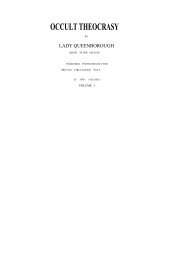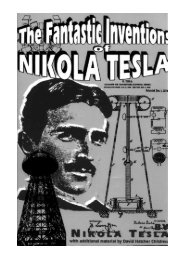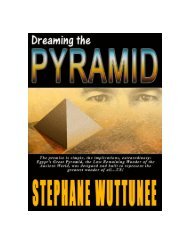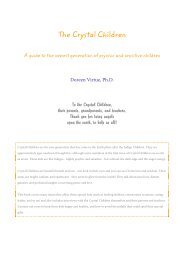the fantastic inventions of nikola tesla - Exopolitics Hong Kong
the fantastic inventions of nikola tesla - Exopolitics Hong Kong
the fantastic inventions of nikola tesla - Exopolitics Hong Kong
You also want an ePaper? Increase the reach of your titles
YUMPU automatically turns print PDFs into web optimized ePapers that Google loves.
obtainable at any point <strong>of</strong> <strong>the</strong> universe. This idea is not novel. Men have been led to it long ago by instinct or<br />
reason. It has been expressed in many ways, and in many places, in <strong>the</strong> history <strong>of</strong> old and new. We find it in <strong>the</strong><br />
delightful myth <strong>of</strong> An<strong>the</strong>us, who derives power from <strong>the</strong> earth; we find it among <strong>the</strong> subtle speculations <strong>of</strong> one <strong>of</strong><br />
your splendid ma<strong>the</strong>maticians, and in many hints and statements <strong>of</strong> thinkers <strong>of</strong> <strong>the</strong> present time. Throughout space<br />
<strong>the</strong>re is energy. Is this energy static or kinetic? If static our hopes are in vain; if kinetic--and this we know it is, for<br />
certain—<strong>the</strong>n it is a mere question <strong>of</strong> time when men will succeed in attaching <strong>the</strong>ir machinery to <strong>the</strong> very<br />
wheelwork <strong>of</strong> nature. Of all, living or dead, Crookes came nearest to doing it. His radiometer will turn in <strong>the</strong> light<br />
<strong>of</strong> day and in <strong>the</strong> darkness <strong>of</strong> <strong>the</strong> night; it will turn everywhere where <strong>the</strong>re is heat, and heat is everywhere. But,<br />
unfortunately, this beautiful little machine, while it goes down to posterity as <strong>the</strong> most interesting, must likewise be<br />
put on record as <strong>the</strong> most inefficient machine ever invented!<br />
The preceding experiment is only one <strong>of</strong> many equally interesting experiments which may be performed by <strong>the</strong> use<br />
<strong>of</strong> only one wire with alternate currents <strong>of</strong> high potential and frequency. We may connect an insulated line to a<br />
source <strong>of</strong> such currents, we may pass an inappreciable current over <strong>the</strong> line, and on any point <strong>of</strong> <strong>the</strong> same we are<br />
able to obtain a heavy current, capable <strong>of</strong> fusing a thick copper wire. Or we may, by <strong>the</strong> help <strong>of</strong> some artifice, decompose<br />
a solution in any electrolytic cell by connecting only one pole <strong>of</strong> <strong>the</strong> cell to <strong>the</strong> line or source <strong>of</strong> energy.<br />
Or we may, by attaching to <strong>the</strong> line, or only bringing into its vicinity, light up an incandescent lamp, an exhausted<br />
tube, or a phosphorescent bulb.<br />
However impracticable this plan <strong>of</strong> working may appear in many cases, it certainly seems practicable, and even<br />
recommendable, in <strong>the</strong> production <strong>of</strong> light. A perfected lamp would require but little energy, and if wires were used<br />
at all we ought to be able to supply that energy without a return wire.<br />
It is now a fact that a body may be rendered incandescent or phosphorescent by bringing it ei<strong>the</strong>r in single contact<br />
or merely in <strong>the</strong> vicinity <strong>of</strong> a source <strong>of</strong> electric impulses <strong>of</strong> <strong>the</strong> proper character, and that m this manner a quantity<br />
<strong>of</strong> light sufficient to afford a practical illuminant may be produced. It is, <strong>the</strong>refore, to say <strong>the</strong> least, worth while to<br />
attempt to determine <strong>the</strong> best conditions and to invent <strong>the</strong> best appliances for attaining this object.<br />
Some experiences have already been gained in this direction, and I will dwell on <strong>the</strong>m briefly, in <strong>the</strong> hope that <strong>the</strong>y<br />
might prove useful.<br />
The heating <strong>of</strong> a conducting body inclosed in a bulb, and connected to a source <strong>of</strong> rapidly alternating electric impulses,<br />
is dependent on so many things <strong>of</strong> a different nature, that it would be difficult to give a generally applicable<br />
rule under which <strong>the</strong> maximum heating occurs. As regards <strong>the</strong> size <strong>of</strong> <strong>the</strong> vessel, I have lately found that at ordinary<br />
or only slightly differing atmospheric pressures, when air is a good insulator, and hence practically <strong>the</strong> same<br />
amount <strong>of</strong> energy by a certain potential and frequency is given <strong>of</strong>f from <strong>the</strong> body, whe<strong>the</strong>r <strong>the</strong> bulb be small or<br />
large, <strong>the</strong> body is brought to a higher temperature if inclosed in a small bulb, because <strong>of</strong> <strong>the</strong> better confinement <strong>of</strong><br />
heat in this case.<br />
At lower pressures, when air becomes more or less conducting, or if <strong>the</strong> air be sufficiently warmed as to become<br />
conducting, <strong>the</strong> body is rendered more intensely incandescent in a large bulb, obviously because, under o<strong>the</strong>rwise<br />
equal conditions <strong>of</strong> test, more energy may be given <strong>of</strong>f from <strong>the</strong> body when <strong>the</strong> bulb is large.<br />
At very high degrees <strong>of</strong> exhaustion, when <strong>the</strong> matter in <strong>the</strong> bulb becomes "radiant," a large bulb has still an advantage,<br />
but a comparatively slight one, over <strong>the</strong> small bulb.<br />
Finally, at excessively high degrees <strong>of</strong> exhaustion, which cannot be reached except by <strong>the</strong> employment <strong>of</strong> special<br />
means, <strong>the</strong>re seems to be, beyond a certain and ra<strong>the</strong>r small size <strong>of</strong> vessel, no perceptible difference in <strong>the</strong> heating.<br />
These observations were <strong>the</strong> result <strong>of</strong> a number <strong>of</strong> experiments, <strong>of</strong> which one, showing <strong>the</strong> effect <strong>of</strong> <strong>the</strong> size <strong>of</strong> <strong>the</strong><br />
bulb at a high degree <strong>of</strong> exhaustion, may be described and shown here, as it presents a feature <strong>of</strong> interest. Three<br />
spherical bulbs <strong>of</strong> 2 inches, 3 inches and 4 inches diameter were taken, and in <strong>the</strong> centre <strong>of</strong> each was mounted an<br />
equal length <strong>of</strong> an ordinary incandescent lamp filament <strong>of</strong> uniform thickness. In each bulb <strong>the</strong> piece <strong>of</strong> filament was<br />
fastened to <strong>the</strong> leading-in wire <strong>of</strong> platinum, contained in a glass stem sealed in <strong>the</strong> bulb; care being taken, <strong>of</strong> course,<br />
to make everything as nearly alike as possible. On each glass stem in <strong>the</strong> inside <strong>of</strong> <strong>the</strong> bulb was slipped a highly<br />
polished tube made <strong>of</strong> aluminium sheet, which fitted <strong>the</strong> stem and was held on it by spring pressure. The function<br />
<strong>of</strong> this aluminium tube will be explained subsequently. In each bulb an equal length <strong>of</strong> filament protruded above<br />
<strong>the</strong> metal tube. It is sufficient to say now that under <strong>the</strong>se conditions equal lengths <strong>of</strong> filament <strong>of</strong> <strong>the</strong> same thickness—in<br />
o<strong>the</strong>r words, bodies <strong>of</strong> equal bulk—were brought to incandescence. The three bulbs were sealed to a glass<br />
tube, which was connected to a Sprengel pump. When a high vacuum had been reached, <strong>the</strong> glass tube carrying <strong>the</strong><br />
bulbs was sealed <strong>of</strong>f. A current was <strong>the</strong>n turned on successively on each bulb, and it was found that <strong>the</strong> filaments<br />
came to about <strong>the</strong> same brightness, and, if anything, <strong>the</strong> smallest bulb, which was placed midway between <strong>the</strong> two









